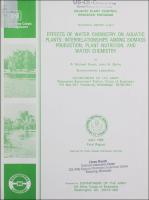Please use this identifier to cite or link to this item:
https://hdl.handle.net/11681/6315Full metadata record
| DC Field | Value | Language |
|---|---|---|
| dc.contributor.author | Smart, R. Michael | en_US |
| dc.contributor.author | Barko, John W. | en_US |
| dc.creator | Aquatic Plant Control Research Program (U.S.) | en_US |
| dc.creator | Environmental Laboratory (U.S.) | en_US |
| dc.date.accessioned | 2016-03-23T19:54:32Z | en_US |
| dc.date.available | 2016-03-23T19:54:32Z | en_US |
| dc.date.issued | 1988-04 | en_US |
| dc.identifier.govdoc | Technical Report A-88-5 | en_US |
| dc.identifier.uri | http://hdl.handle.net/11681/6315 | en_US |
| dc.description | Technical Report | en_US |
| dc.description.abstract | Growth of the submersed aquatic plants Egeria densa, Hydrilla verticillata, and Potamogeton nodosus was examined under two aeration regimes (ambient air and carbon dioxide (CO2)-enriched air) in three solutions differing in levels of major cations (calcium (Ca), magnesium (Mg), sodium (Na), and potassium (K)) and inorganic carbon (C𝚝). Study objectives were to evaluate the effects of plant growth on solution chemical composition; interrelationships among solution chemistry, plant growth, and nutrition; and the relative importance of solution and sediment as potent ial growth-limiting factors. Submersed aquatic plant growth resulted in significant depletions of solution C𝚝, Ca, and K, but not Na or Mg. Depletions of solution C𝚝 and Ca were due to the combined effects of photosynthetic C𝚝 uptake and calcium carbonate precipitation. Aeration with a fourfold enrichment in CO2 concentration did not prevent depletion of solution C𝚝 or Ca, indicating that plant photosynthetic requirements were greatly in excess of the added CO2. Depletions of solution K were attributed to foliar uptake of K. Plant growth was shown to be limited by inorganic carbon supply in the low-cation, low-carbon solution, and by sediment nitrogen (N) availability in the higher cation, higher carbon solutions. The response of submersed aquatic plants to solution was thus affected by sediment N supply. While plant requirements of N and P (phosphorus) were provided by root uptake from sediment, K was provided by foliar uptake from solution. Both inorganic carbon and sediment N were identified as factors potentially limiting the growth of field populations of submersed aquatic plants. | en_US |
| dc.description.sponsorship | Aquatic Plant Control Research Program (U.S.) | en_US |
| dc.description.sponsorship | United States. Army. Corps of Engineers | en_US |
| dc.description.tableofcontents | Preface................................1 Introduction................................3 Background................................3 Study Objectives................................4 Materials and Methods................................5 Results and Discussion................................8 Effects of plant growth on solution chemistry................................8 Effects of solution on plant growth and nutrition................................14 Plant growth and nutrition effects on solution composition................................20 Relative importance of carbon and nitrogen limitation................................22 Conclusions and Recommendations................................24 References................................25 | en_US |
| dc.format.extent | 29 pages/5.86 MB | en_US |
| dc.format.medium | en_US | |
| dc.language.iso | en_US | en_US |
| dc.publisher | U.S. Army Engineer Waterways Experiment Station | en_US |
| dc.relation | http://acwc.sdp.sirsi.net/client/en_US/search/asset/1043711 | en_US |
| dc.relation.ispartofseries | Technical Report (Aquatic Plant Control Research Program (U.S.)) ; no.Technical Report A-88-5 | en_US |
| dc.rights | Approved for public release; distribution is unlimited | en_US |
| dc.source | This Digital Resource was created from scans of the Print Resource | en_US |
| dc.subject | Aquatic plants | en_US |
| dc.subject | Submersed macrophytes | en_US |
| dc.subject | Aquatic weeds | en_US |
| dc.subject | Carbon limitation | en_US |
| dc.subject | Water chemistry | en_US |
| dc.subject | Egeria densa | en_US |
| dc.subject | Hydrilla verticillata | en_US |
| dc.subject | Potamogeton nodosus | en_US |
| dc.subject | Nutrient limitation | en_US |
| dc.subject | Nutrient uptake | en_US |
| dc.subject | Aquatic Plant Control Research Program (U.S.) | en_US |
| dc.title | Effects of water chemistry on aquatic plants : interrelationships among biomass production, plant nutrition, and water chemistry | en_US |
| dc.type | Report | en_US |
| Appears in Collections: | Technical Report | |
Files in This Item:
| File | Description | Size | Format | |
|---|---|---|---|---|
| TR-A-88-5.pdf | Technical Report A-88-5 | 5.86 MB | Adobe PDF |  View/Open |